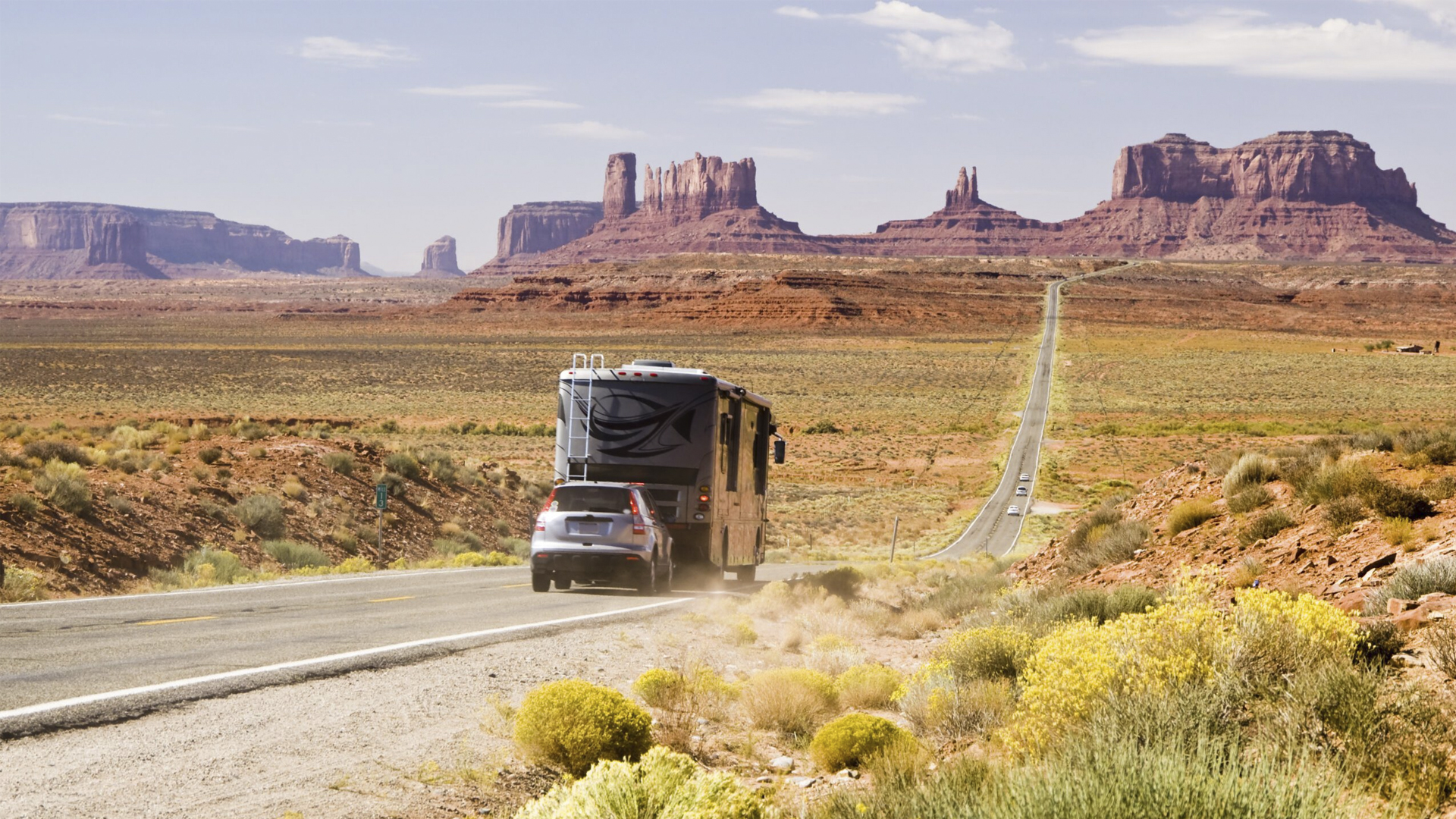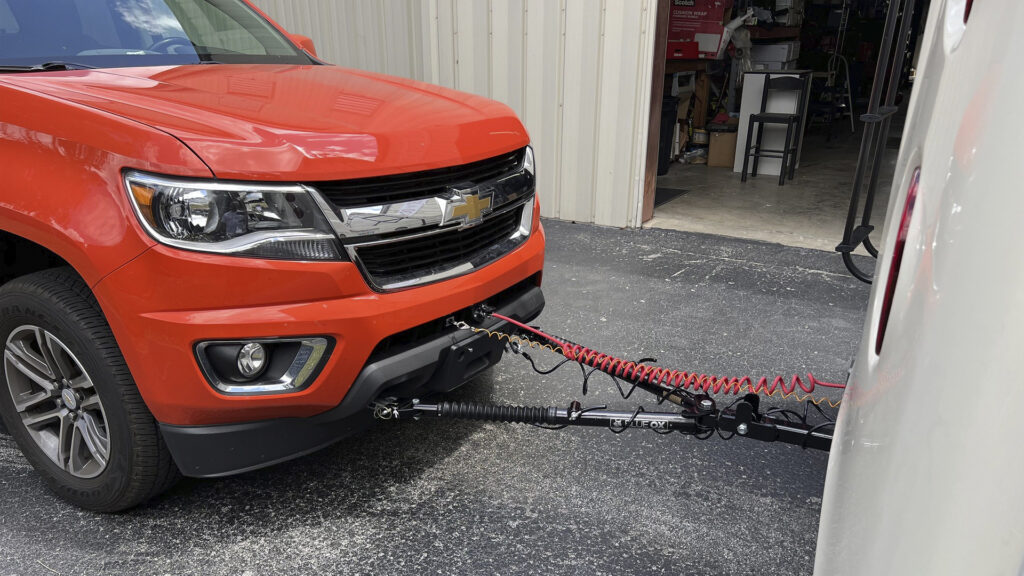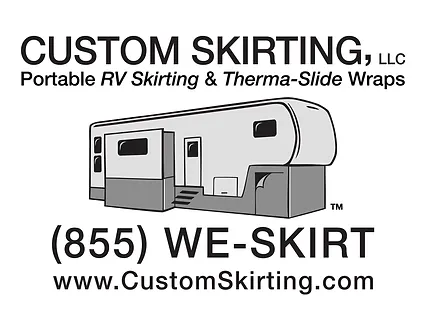
What Vehicles Can Be Flat Towed with Your RV?
Table of contents
If you’re an RV owner or planning to hit the open road with your motorhome, you might be wondering: what vehicles can be flat towed? Flat towing offers RV travelers the unique advantage of having a vehicle available for exploring when you’re parked, without the need to relocate your RV. It’s a practical and convenient way to enjoy your adventures, providing freedom to roam without the hassle of moving your large motorhome every time you need to make a quick trip. In this guide, we’ll explore the ins and outs of flat tow vehicles, flat towable vehicles, and how to choose the right one for your travels. We’ll break down the concept of flat towing, its benefits, and the specific requirements to keep in mind when selecting a vehicle to tow behind your motorhome. Whether you’re new to RVing or a seasoned traveler, knowing what vehicles can be flat towed will help you make an informed decision.
Understanding Flat Towing Requirements
Flat towing, also known as “four-down towing,” refers to towing a vehicle with all four wheels on the ground, as opposed to using a dolly or trailer. While flat towing can provide unmatched convenience and flexibility, it’s important to understand the key requirements to ensure safe and effective towing.
Transmission Types Suitable for Flat Towing
When considering flat towable vehicles, the transmission type is one of the first factors to consider. Manual transmission vehicles are generally the most compatible with flat towing because they don’t rely on the vehicle’s automatic transmission fluid pump for lubrication when the engine is off. This makes them ideal for towing with no risk of transmission damage.
On the other hand, automatic transmissions are often more challenging when flat towing. Many automatic vehicles require special modifications, such as a transmission lube pump, to prevent transmission damage. Fortunately, some newer automatic vehicles are designed for flat towing and come with specific towing guidelines in their owner’s manual.
Drivetrain Considerations
The drivetrain of the vehicle — whether it’s front-wheel drive (FWD), rear-wheel drive (RWD), or four-wheel drive (4WD) — plays a critical role in determining what vehicles can be flat towed behind a motorhome.
- Front-wheel drive vehicles are often good candidates for flat towing, as their front wheels are engaged in both driving and steering. However, you must ensure that the vehicle is compatible and doesn’t require any special modifications.
- Rear-wheel drive vehicles can also be flat towed but are generally less common, as their drivetrains don’t engage the front wheels for steering. Many of these vehicles require a special setup to avoid damage to the transmission and drivetrain.
- Four-wheel drive (4WD) vehicles are among the best for flat towing. They are designed with transfer cases that allow the transmission and drivetrain to remain disengaged when towing. Vehicles like the Jeep Wrangler and Jeep Grand Cherokee are popular among RV owners for this reason.
Vehicle Weight and Size
When considering what vehicles can be flat towed, it’s essential to match the towed vehicle’s weight with your RV’s towing capacity. RVs come with a specific weight limit, and towing a vehicle that exceeds this limit can cause strain on both the RV and the towing setup. Lighter vehicles are typically preferred, as they put less strain on the RV’s engine and transmission, allowing for easier towing.
Popular Vehicle Categories for Flat Towing

There are several categories of vehicles that make excellent candidates for flat towing, each offering distinct advantages for RV travelers. Here’s a breakdown of some popular types of flat tow vehicles:
Compact and Subcompact Cars
Compact and subcompact cars like the Chevrolet Sonic and Ford Focus are ideal choices for flat towing. These vehicles are lightweight, fuel-efficient, and easy to tow, making them perfect for RV owners who want a reliable and easy-to-maneuver vehicle to explore their destinations. Their small size also makes them ideal for navigating tight parking spaces.
SUVs and Crossovers
For RV owners seeking more space and versatility, SUVs and crossovers are excellent flat towable vehicles. The Jeep Wrangler is arguably the most popular flat tow vehicle, known for its off-road capabilities and rugged build. Other vehicles like the Jeep Grand Cherokee offer a good balance of towing capability and comfort, making them great options for long-term RV trips.
Pickup Trucks
If you’re looking for a vehicle that can handle rough terrain or carry extra gear, a pickup truck like the Ford F-150 can be a great choice for flat towing. Pickup trucks offer a large cargo space and are often equipped with 4WD capabilities, making them ideal for adventuring off the beaten path.
Specific Vehicle Recommendations
When you’re selecting flat towable vehicles, it’s important to consider specific models known for their compatibility with flat towing setups. Here are a few top recommendations:
Jeep Wrangler
The Jeep Wrangler is often considered the gold standard for flat towing. With its 4WD drivetrain, manual transmission options, and off-road prowess, it’s a favorite among RV owners. The Wrangler is designed with flat towing in mind, and many models feature easy-to-use systems for disengaging the drivetrain to make towing safe and simple. Whether you’re tackling mountain roads or exploring desert trails, the Wrangler offers the versatility and reliability you need in a flat tow vehicle.
Ford F-150
The Ford F-150 is a popular pickup truck that can be flat towed behind a motorhome. With its strong towing capacity, robust drivetrain, and customizable options, it’s an excellent choice for RV owners who need a workhorse for towing trailers or carrying extra cargo. It’s also available in 4WD, making it suitable for flat towing in various terrains.
Chevrolet Equinox
The Chevrolet Equinox is a compact crossover SUV that offers a comfortable and practical ride. Its FWD configuration and relatively light weight make it an excellent choice for those looking for a smooth, easy-to-tow vehicle. Plus, the Equinox is spacious enough to carry gear and passengers, making it a great option for RV travelers who want a balance of comfort and capability.
Modifications and Equipment for Flat Towing
Flat towing requires specific equipment and, in some cases, modifications to the towed vehicle. Here’s an overview of what you’ll need:
Tow Bars and Base Plates
A tow bar is essential for flat towing, as it connects the RV to the towed vehicle. It’s important to choose a tow bar that matches your vehicle and RV. Brands like Blue Ox offer quality tow bars, but it’s crucial to pair the right tow bar with the appropriate base plates designed specifically for your vehicle. These components ensure that the towing connection is secure, reducing the risk of accidents or damage.
Auxiliary Braking Systems
An auxiliary braking system like the Blue Ox Patriot Brake helps to control the towed vehicle’s braking. Many states require this additional safety feature, as it prevents the towed vehicle from pushing against the RV during braking. Ensuring that your vehicle is equipped with an auxiliary braking system can improve safety and prevent potential damage.
Transmission and Drivetrain Modifications
Some vehicles require modifications to their transmission or drivetrain. This can include the installation of a transmission lubrication pump or modifications to the drivetrain to prevent damage. These modifications can be costly and may affect the vehicle’s warranty, so it’s important to consult with a professional before making any changes.
Safety Considerations and Best Practices

Flat towing is generally safe when done correctly, but it’s important to follow proper procedures to ensure that the vehicle and RV remain in good condition.
Pre-Towing Checklist
It’s essential to conduct a pre-towing checklist to ensure everything is properly connected and secured. Check the tow bar, base plates, and any electrical connections, such as lights and brakes. Always verify that the vehicle’s transmission is in the proper mode for towing.
Driving Tips When Flat Towing
Be aware that stopping distances will be longer, and turning radius will be wider. Avoid backing up with the towed vehicle attached, as this can cause serious damage. Also, take turns slowly and carefully, as the added weight of the towed vehicle can affect the handling of the RV.
Equip Your RV for Long-Term Adventures
Ready for extended RV travels with your flat tow vehicle? Don’t let the cold or harsh conditions slow you down. Upgrade your setup with custom RV skirting! Our on-site, precision-fit skirting protects your RV from water, snow, and wind, ensuring a warmer, more energy-efficient experience no matter where you park.
With our exclusive “No-Snap, No-Gap” channel system, you’ll enjoy unparalleled insulation and durability, tested across the toughest winters in the U.S. and Canada. Designed to move with you, it’s the perfect companion for every adventure.
Start your journey with confidence—contact us today for your custom RV skirting solution!
